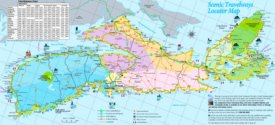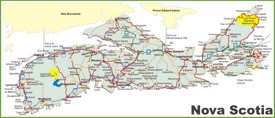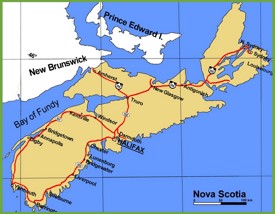Nova Scotia Map
Description:
This map shows cities, towns, villages, province capital, islands, rivers, lakes, highways, and major roads in Nova Scotia.
Size: 1350x1128px / 528 Kb
Author: Ontheworldmap.com
You may download, print or use the above map for educational, personal and non-commercial purposes. Attribution is required. For any website, blog, scientific research or e-book, you must place a hyperlink (to this page) with an attribution next to the image used.
Online Map of Nova Scotia
About Nova Scotia
Nova Scotia occupies the southeastern region of Canada as one of the country's four Atlantic provinces. The province encompasses the Nova Scotia peninsula and Cape Breton Island, covering a total area of 21,345 square miles (55,284 square kilometers), with land accounting for 20,441 square miles (52,942 square kilometers) and water comprising 904 square miles (2,342 square kilometers). The Atlantic Ocean borders Nova Scotia to the east and south, while the Bay of Fundy lies to the west and the Gulf of Saint Lawrence to the north. The province connects to New Brunswick via the narrow Chignecto Isthmus, making New Brunswick its only land border. Maritime boundaries separate Nova Scotia from Prince Edward Island to the north and Newfoundland and Labrador to the northeast.
As of 2025, Nova Scotia's population reaches approximately 1,093,000 residents, making it the most populous province in Atlantic Canada and the seventh most populous in the country. The province ranks as Canada's second most densely populated province with approximately 18.3 people per square kilometer (47.4 per square mile). Halifax serves as both the provincial capital and largest city, with a metropolitan population exceeding 440,000 residents—nearly half of the province's total population. Other significant urban centers include Cape Breton (97,398 residents), Truro (12,261), and Sydney, which functions as the primary city on Cape Breton Island.
The provincial economy traditionally relied on natural resources, particularly fishing along the Scotian Shelf, though recent decades have brought significant diversification. The 2020 gross domestic product totaled 46.8 billion Canadian dollars. Key economic sectors include agriculture (concentrated in the Annapolis Valley), fishing and seafood processing (especially lobster, scallops, and crab), forestry, offshore oil and gas extraction, manufacturing (with Michelin operating three major facilities), information technology, defense and aerospace, and financial services. The tourism industry contributes approximately 3.5 billion dollars annually to the economy, with over 2 million non-resident visitors in 2024.
Tourism centers on Nova Scotia's dramatic coastal scenery, maritime heritage, and historic sites. Major attractions include Peggy's Cove, home to Canada's most photographed lighthouse built in 1914; the Cabot Trail, a 300-kilometer scenic highway through Cape Breton Highlands National Park; Lunenburg, a UNESCO World Heritage Site preserving 18th and 19th-century British colonial architecture; the Halifax Citadel National Historic Site, an 18th-century military fortress overlooking Halifax Harbour; Kejimkujik National Park, offering wilderness canoeing and hiking; the Bay of Fundy, featuring the world's highest tides; and the Fortress of Louisbourg, Canada's largest historical reconstruction depicting French colonial life from 1713 to 1758. The province's 7,600 kilometers of coastline provide numerous beaches, fishing villages, and opportunities for whale watching, with twelve whale species frequenting coastal waters.
The Facts:
| Capital: | Halifax |
| Largest city: | Halifax |
| Population (Q3 2025): | 1,093,245[1] |
| Area: | 21,345 sq mi (55,284 sq km) |
| Density: | 47.4/sq mi (18.31/sq km) |
| Official languages: | English |
| Coordinates: | 45°N 63°W |
| Gross domestic product (Total): | CA$46.849 billion |
| Gross domestic product (Per capita): | CA$52,390 |
| Time zone: |
Time zone - UTC-04:00 (Atlantic) Summer (DST) - UTC-03:00 (ADT) |
| Canadian postal abbr.: | NS |
| Postal code prefix: | B |
| ISO 3166 code: | CA-NS |
| Flower: | Mayflower |
| Tree: | Red spruce |
| Bird: | Osprey |
| Official Website: | www.novascotia.ca |
Google Map of Nova Scotia
List of Cities, Towns, and Villages in Nova Scotia
- Truro
- New Glasgow
- Amherst
- Bridgewater
- Yarmouth
- Kentville
- Wolfville
- Antigonish
- Stellarton
- Westville
- Port Hawkesbury
- Pictou
- Berwick
- Trenton
- Lunenburg
- Digby
- Middleton
- Shelburne
- Stewiacke
- Oxford
- Mahone Bay
- Clark's Harbour
- Mulgrave
- Annapolis Royal
- Lockeport
- Bedford
- Bridgetown
- Canso
- Dominion
- Glace Bay
- Hantsport
- Inverness
- Joggins
- Liverpool
- Louisbourg
- New Waterford
- North Sydney
- Parrsboro
- Port Hood
- Springhill
- Sydney Mines
- Wedgeport
- Windsor
- Halifax
- Cape Breton
- Kingston
- Enfield
- Still Water Lake
- Eskasoni
- Lake Echo
- Indian Brook
- Brookside
- Chester
- Centreville
- Howie Centre
- Hayes Subdivision
- Port Williams
- Lantz
- Sydney
- Greenwood
Main sights in Nova Scotia
- Peggy's Cove Lighthouse
- Halifax Citadel National Historic Site
- Cape Breton Highlands National Park
- Halifax Waterfront Boardwalk
- Fortress of Louisbourg National Historic Site
- Lunenburg Old Town (UNESCO World Heritage Site)
- Halifax Public Gardens
- Cabot Trail
- Maritime Museum of the Atlantic
- Alexander Graham Bell National Historic Site
- Grand-Pré National Historic Site
- Pier 21 National Historic Site
- Skyline Trail
- Kejimkujik National Park
- Bay of Fundy
- Bluenose II
- Annapolis Royal Historic District
- Fisheries Museum of the Atlantic
- Port-Royal National Historic Site
- Joggins Fossil Cliffs (UNESCO World Heritage Site)
- Halifax Central Library
- Art Gallery of Nova Scotia
- Cape Forchu Lighthouse
- Burntcoat Head Park
- Sable Island National Park Reserve
- Province House
- HMCS Sackville
- Georges Island National Historic Site
- Sherbrooke Village
- Cape d'Or Lighthouse
References
1. ^ Population estimates, quarterly. Statistics Canada.Maps of Canada
Provinces and Territories
Cities of Canada
Cities of Canada








